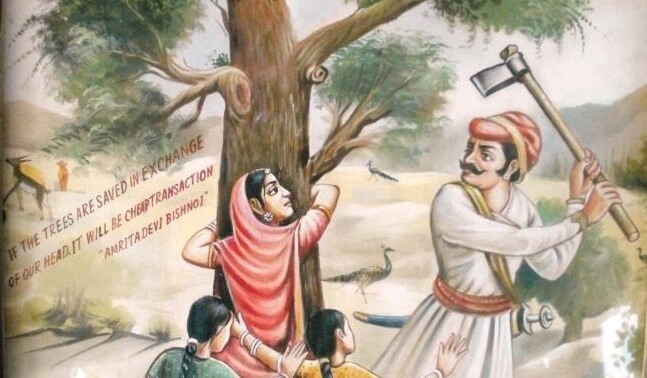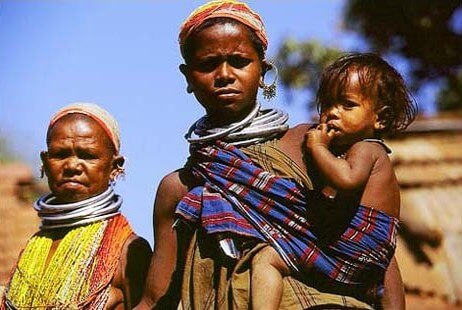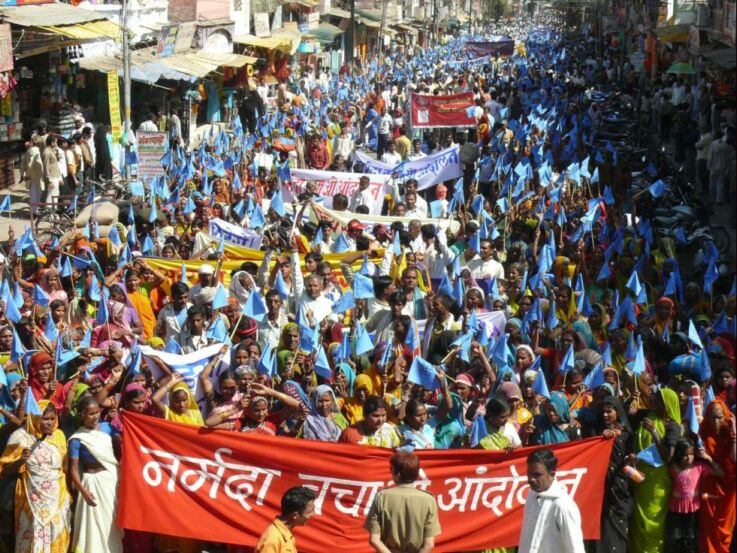
Contemporary India experiences almost unrestricted exploitation of resources because of the lure of new consumerist lifestyles.
The balance of nature is disrupted. This has led to many conflicts in society.
In this article, we discuss the major environmental movements in India.
What is an Environmental Movement?

- An environmental movement can be defined as a social or political movement, for the conservation of the environment or for the improvement of the state of the environment. The terms ‘green movement’ or ‘conservation movement’ are alternatively used to denote the same.
- The environmental movements favour the sustainable management of natural resources. The movements often stress the protection of the environment via changes in public policy. Many movements are centred on ecology, health and human rights.
- Environmental movements range from highly organized and formally institutionalized ones to radically informal activities.
- The spatial scope of various environmental movements ranges from being local to almost global.
Major Environmental Movements in India
Some of the major environmental movements in India during the period 1700 to 2000 are the following.
Bishnoi Movement

- Year: 1700s
- Place: Khejarli, Marwar region, Rajasthan state.
- Leaders: Amrita Devi along with Bishnoi villagers in Khejarli and surrounding villages.
- Aim: Save sacred trees from being cut down by the king’s soldiers for a new palace.
What was it all about: Amrita Devi, a female villager could not bear to witness the destruction of both her faith and the village’s sacred trees. She hugged the trees and encouraged others to do the same. 363 Bishnoi villagers were killed in this movement.
The Bishnoi tree martyrs were influenced by the teachings of Guru Maharaj Jambaji, who founded the Bishnoi faith in 1485 and set forth principles forbidding harm to trees and animals. The king who came to know about these events rushed to the village and apologized, ordering the soldiers to cease logging operations. Soon afterwards, the maharajah designated the Bishnoi state as a protected area, forbidding harm to trees and animals. This legislation still exists today in the region.
Chipko Movement

- Year: 1973
- Place: In Chamoli district and later in Tehri-Garhwal district of Uttarakhand.
- Leaders: Sundarlal Bahuguna, Gaura Devi, Sudesha Devi, Bachni Devi, Chandi Prasad Bhatt, Govind Singh Rawat, Dhoom Singh Negi, Shamsher Singh Bisht and Ghanasyam Raturi.
- Aim: The main objective was to protect the trees on the Himalayan slopes from the axes of contractors of the forest.
What was it all about: Mr. Bahuguna enlightened the villagers by conveying the importance of trees in the environment which check the erosion of soil, cause rains and provide pure air. The women of Advani village of Tehri-Garhwal tied the sacred thread around the trunks of trees and they hugged the trees, hence it was called the ‘Chipko Movement’ or ‘hug the tree movement’.
The main demand of the people in these protests was that the benefits of the forests (especially the right to fodder) should go to local people. The Chipko movement gathered momentum in 1978 when the women faced police firings and other tortures.
The then state Chief Minister, Hemwati Nandan Bahuguna set up a committee to look into the matter, which eventually ruled in favour of the villagers. This became a turning point in the history of eco-development struggles in the region and around the world.
Save Silent Valley Movement

- Year: 1978
- Place: Silent Valley, an evergreen tropical forest in the Palakkad district of Kerala, India.
- Leaders: The Kerala Sastra Sahitya Parishad (KSSP) an NGO, and the poet-activist Sughathakumari played an important role in the Silent Valley protests.
- Aim: To protect the Silent Valley, the moist evergreen forest from being destroyed by a hydroelectric project.
What was it all about: The Kerala State Electricity Board (KSEB) proposed a hydroelectric dam across the Kunthipuzha River that runs through Silent Valley. In February 1973, the Planning Commission approved the project at a cost of about Rs 25 crores. Many feared that the project would submerge 8.3 sq km of untouched moist evergreen forest. Several NGOs strongly opposed the project and urged the government to abandon it.
In January 1981, bowing to unrelenting public pressure, Indira Gandhi declared that Silent Valley will be protected. In June 1983 the Center re-examined the issue through a commission chaired by Prof. M.G.K. Menon. In November 1983 the Silent Valley Hydroelectric Project was called off. In 1985, Prime Minister Rajiv Gandhi formally inaugurated the Silent Valley National Park.
Jungle Bachao Andholan

- Year: 1982
- Place: Singhbhum district of Bihar
- Leaders: The tribals of Singhbhum.
- Aim: Against the government’s decision to replace the natural sal forest with Teak.
What was it all about: The tribals of the Singhbhum district of Bihar started the protest when the government decided to replace the natural sal forests with the highly-priced teak. This move was called by many “Greed Game Political Populism”. Later this movement spread to Jharkhand and Orissa.
Appiko Movement

- Year: 1983
- Place: Uttara Kannada and Shimoga districts of Karnataka State
- Leaders: Appiko’s greatest strengths lie in it being neither driven by a personality nor having been formally institutionalised. However, it does have a facilitator in Pandurang Hegde. He helped launch the movement in 1983.
- Aim: Against the felling and commercialization of natural forest and the ruin of ancient livelihood.
What was it all about: It can be said that the Appiko movement is the southern version of the Chipko movement. The Appiko Movement was locally known as “Appiko Chaluvali”. The locals embraced the trees which were to be cut by contractors of the forest department. The Appiko movement used various techniques to raise awareness such as foot marches in the interior forest, slide shows, folk dances, street plays etc.
The second area of the movement’s work was to promote afforestation on denuded lands. The movement later focused on the rational use of the ecosphere by introducing alternative energy resource to reduce pressure on the forest. The movement became a success. The current status of the project is – stopped.
Narmada Bachao Andholan (NBA)

- Year: 1985
- Place: Narmada River, which flows through the states of Gujarat, Madhya Pradesh and Maharashtra.
- Leaders: Medha Patker, Baba Amte, Adivasis, farmers, environmentalists and human rights activists.
- Aim: A social movement against several large dams being built across the Narmada River.
What was it all about: The movement first started as a protest for not providing proper rehabilitation and resettlement for the people who have been displaced by the construction of the Sardar Sarovar Dam. Later on, the movement turned its focus on the preservation of the environment and the eco-systems of the valley. Activists also demanded the height of the dam to be reduced to 88 m from the proposed height of 130m. World Bank withdrew from the project.
The environmental issue was taken into court. In October 2000, the Supreme Court gave a judgment approving the construction of the Sardar Sarovar Dam with a condition that the height of the dam could be raised to 90 m. This height is much higher than the 88 m which anti-dam activists demanded, but it is definitely lower than the proposed height of 130 m. The project is now largely financed by the state governments and market borrowings. The project is expected to be fully completed by 2025.
Although not successful, as the dam could not be prevented, the NBA has created an anti-big dam opinion in India and outside. It questioned the paradigm of development. As a democratic movement, it followed the Gandhian way 100 per cent.
Tehri Dam Conflict

- Year: 1990’s
- Place: Bhagirathi River near Tehri in Uttarakhand.
- Leaders: Sundarlal Bahuguna
- Aim: The protest was against the displacement of town inhabitants and the environmental consequence of the weak ecosystem.
Tehri Dam attracted national attention in the 1980s and the 1990s. The major objections include seismic sensitivity of the region, the submergence of forest areas along with Tehri town etc. Despite the support from other prominent leaders like Sunderlal Bahuguna, the movement has failed to gather enough popular support at the national as well as international levels.
Reference:
Article by: Priyanka Sunil






V.v.useful info.thank u so much sir
Happy to help
Thank you very much clearias.com .
Tq very much to clear IAS team
Wonder ful information
In brief way
Ty very much. It was really very helpful to me
It is a very important issue for mains.Thank you clear IAS team.
Hi,
You are providing valuable information for competitive exam’s.
Here in this article you have written about “Chipko Movement” is started from Tehri Garhwal.
“Chipko Movement” was started from “Reni Village” of Chamoli ditrtict, which is near “Joshimath”.
So, plz correct that.
Thanks Udit for pointing it out. We have updated the article.
The struggle Chipko’s first battle took place in early 1973 in Chamoli district, when the villagers of Mandal, led by Bhatt and the Dasholi Gram Swarajya Mandal (DGSM), prevented the Allahabad-based sports goods company, Symonds, from felling 14 ash trees. In Tehri Garhwal, Chipko activists led by Sunderlal Bahuguna began organising villagers from May 1977 to oppose tree-felling in the Henwal valley.
Very Nice Sir.
Nice ,I came to know about few things today
Thanku sir for explaination. It really helps me
Thank you so much it helped me to do my project
very nice information sir
Thank you so much.
Keep it up👍!
Thank you so much
You helped me project😄👍
Hello sir my name pratap I live in jajpur,odisha . One request sir in jajpur tha environment is polluted because here 17 factory are avelebul .Sir my request is save our children ….Plz sir
Thnq for the info sir ! This is quite interesting Nd also helpful for my xam tomorrow
Good information. Sir. I. Gained some knowledge from this
Thank you so much for giving such a important information
Do you have youtube channel.
As the information provided by you is awesome.
Yes. We have @clearias. You can find the link in the footer section.
thank you so much sir.It helped me very much
Need more information
Thanks…
Need more information plz
Amazingly described!
Helped a alot !!!!
Thanks 🙂
Thanks for your help
Yes. This is the best Topic. Wonderful
thank you its help to me for my semister examination
Thank You So Much for helping us with the valuable content.
Thankyou so much clerias.com. Really it is very helpful to all.
Okeh😎
It’s my pleasure
It’s really helpful . Thank you so much 💖🖤
But Silent movement is an environmental movement in Kerala so it’s a state movement
according to my text book
Any way this work really awesome and helpful for my project as a referring guide THANK YOU ❤💌
Thank you clearias.com…..you save me …this notes is very helpful for my upcoming exams thanks a lot….keep it up…..
it’s good information, nice work.
Singhbhum district is not in Bihar it is Jharkhand.
If you’re mentioning before the partition of the state then you shouldn’t mention the line ” then it was spread in Jharkhand and Orissa”.
Please keep your information correct.
It’s really so useful
Excellent information ..Thankyou
It’s really very much helpful . Thank you
But Silent movement is an environmental movement Which must be going in India and Worldwide for water and wastewater treatment.
Any way this work really awesome and helpful for my research as a referring guide
THANK YOU 💌
nice article.